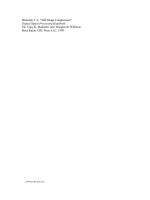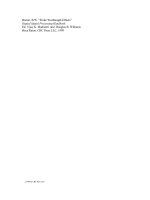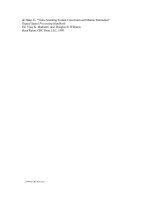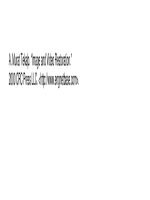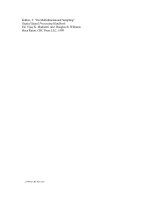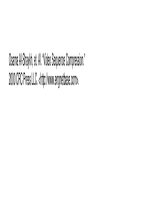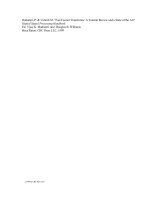drilling fluids processing handbook
Bạn đang xem bản rút gọn của tài liệu. Xem và tải ngay bản đầy đủ của tài liệu tại đây (9.98 MB, 693 trang )
TeAM
YYePG
Digitally signed by TeAM YYePG
DN: cn=TeAM YYePG, c=US,
o=TeAM YYePG, ou=TeAM
YYePG, email=
Reason: I attest to the accuracy
and integrity of this document
Date: 2005.02.22 05:32:12
+08'00'
DRILLING FLUIDS PROCESSING
HANDBOOK
This page intentionally left blank
DRILLING FLUIDS
PROCESSING
HANDBOOK
Asme
AMSTERDAM BOSTON HEIDELBERG LONDON NEW YORK OXFORD
PARIS SAN DIEGO SAN FRANCISCO SINGAPORE SYDNEY TOKYO
Gulf Professional Publishing is an imprint of Elsevier
Gulf Professional Publishing is an imprint of Elsevier
30 Corporate Drive, Suite 400, Burlington, MA 01803, USA
Linacre House, Jordan Hill, Oxford OX2 8DP, UK
Copyright ß 2005, Elsevier Inc. All rights reserved.
No part of this publication may be reproduced, stored in a retrieval system, or
transmitted in any form or by any means, electronic, mechanical, photocopying,
recording, or otherwise, without the prior written permission of the publisher.
Permissions may be sought directly from Elsevier’s Science & Technology Rights
Department in Oxford, UK: phone: (þ44) 1865 843830, fax: (þ44) 1865 853333,
e-mail: You may also complete your request on-line
via the Elsevier homepage (), by selecting ‘‘Customer Support’’
and then ‘‘Obtaining Permissions.’’
Recognizing the importance of preserving what has been wirtten, Elsevier prints
its books on acid-free paper whenever possible.
Library of Congress Cataloging-in-Publication Data
Application submitted.
British Library Cataloguing-in-Publication Data
A catalogue record for this book is available from the British Library.
ISBN 0-7506-7775-9
For information on all Gulf Professional Publishing publications visit our Web site
at www.books.elsevier.com
040506070809 10987654321
Printed in the United States of America
CONTENTS
Biographies xvii
Preface xxiii
1 Historical Perspective and Introduction 1
1.1 Scope 1
1.2 Purpose 1
1.3 Introduction 2
1.4 Historical Perspective 4
1.5 Comments 11
1.6 Waste Management 13
2 Drilling Fluids 15
2.1 Drilling Fluid Systems 15
2.1.1 Functions of Drilling Fluids 15
2.1.2 Types of Drilling Fluids 16
2.1.3 Drilling Fluid Selection 17
2.1.4 Separation of Drilled Solids from Drilling Fluids 20
2.2 Characterization of Solids in Drilling Fluids 25
2.2.1 Nature of Drilled Solids and Solid Additives 25
2.2.2 Physical Properties of Solids in Drilling Fluids 26
2.3 Properties of Drilling Fluids 31
2.3.1 Rheology 32
2.4 Hole Cleaning 38
2.4.1 Detection of Hole-Cleaning Problems 38
2.4.2 Drilling Elements That Affect Hole Cleaning 40
2.4.3 Filtration 45
2.4.4 Rate of Penetration 47
2.4.5 Shale Inhibition Potential/We tting Characteristics 51
2.4.6 Lubricity 52
2.4.7 Corrosivity 53
2.4.8 Drilling-Fluid Stability and Maintenance 54
v
2.5 Drilling Fluid Products 54
2.5.1 Colloidal and Fine Solids 54
2.5.2 Macropolymers 55
2.5.3 Conventional Polymers 56
2.5.4 Surface-Active Materials 57
2.6 Health, Safety, and Environment and Waste Management 58
2.6.1 Handling Drilling Fluid Products and Cuttings 58
2.6.2 Drilling Fluid Product Compatibility and Storage
Guidelines 58
2.6.3 Waste Management and Disposal 62
References 66
3 Solids Calculation 69
3.1 Procedure for a More Accurate Low-Gravity Solids
Determination 70
3.1.1 Sample Calculation 73
3.2 Determination of Volume Percentage of Low-Gravity Solids
in Water-Based Drilling Fluid 77
3.3 Rig-Site Determination of Specific Gravity of Drilled
Solids 78
4 Cut Points 81
4.1 How to Determine Cut Point Curves 85
4.2 Cut Point Data: Shale Shaker Example 90
5 Tank Arrangement 93
5.1 Active System 94
5.1.1 Suction and Testing Section 94
5.1.2 Additions Section 95
5.1.3 Removal Section 95
5.1.4 Piping and Equipment Arrangement 96
5.1.5 Equalization 98
5.1.6 Surface Tanks 99
5.1.7 Sand Traps 100
5.1.8 Degasser Suction and Discharge Pit 102
5.1.9 Desander Suction and Discharge Pits 102
5.1.10 Desilter Suction and Discharge Pits (Mud Cleaner/
Conditioner) 103
5.1.11 Centrifuge Suction and Discharge Pits 103
5.2 Auxiliary Tank System 104
5.2.1 Trip Tank 104
5.3 Slug Tank 105
5.4 Reserve Tank(s) 105
vi Contents
6 Scalping Shakers and Gumbo Removal 107
7 Shale Shakers 111
7.1 How a Shale Shaker Screens Fluid 113
7.2 Shaker Description 116
7.3 Shale Shaker Limits 118
7.3.1 Fluid Rheological Properties 119
7.3.2 Fluid Surface Tension 120
7.3.3 Wire Wettability 120
7.3.4 Fluid Density 120
7.3.5 Solids: Type, Size, and Shape 120
7.3.6 Quantity of Solids 121
7.3.7 Hole Cleaning 121
7.4 Shaker Development Summary 121
7.5 Shale Shaker Design 122
7.5.1 Shape of Motion 123
7.5.2 Vibrating Systems 133
7.5.3 Screen Deck Design 134
7.5.4 g Factor 136
7.5.5 Power Systems 140
7.6 Selection of Shale Shakers 143
7.6.1 Selection of Shaker Screens 145
7.6.2 Cost of Removing Drilled Solids 145
7.6.3 Specific Factors 146
7.7 Cascade Systems 148
7.7.1 Separate Unit 150
7.7.2 Integral Unit with Multiple Vibratory Motions 150
7.7.3 Integral Unit with a Single Vibratory Motion 152
7.7.4 Cascade Systems Summary 152
7.8 Dryer Shakers 153
7.9 Shaker User’s Guide 154
7.9.1 Installation 155
7.9.2 Operation 156
7.9.3 Maintenance 157
7.9.4 Operating Guidelines 158
7.10 Screen Cloths 159
7.10.1 Common Screen Cloth Weaves 160
7.10.2 Revised API Designation Sy stem 167
7.10.3 Screen Identification 174
7.11 Factors Affecting Percentage-Separated Curves 174
7.11.1 Screen Blinding 176
7.11.2 Materials of Construction 177
7.11.3 Screen Panels 178
Contents vii
7.11.4 Hook-Strip Screens 180
7.11.5 Bonded Screens 180
7.11.6 Three-Dimensional Screening Surfaces 180
7.12 Non-Oilfield Drilling Uses of Shale Shakers 181
7.12.1 Microtunneling 181
7.12.2 River Crossing 182
7.12.3 Road Crossing 182
7.12.4 Fiber-Optic Cables 182
8 Settling Pits 183
8.1 Settling Rates 183
8.2 Comparison of Settling Rates of Barite and Low-Gravity Drilled
Solids 186
8.3 Comments 187
8.4 Bypassing the Shale Shaker 188
9 Gas Busters, Separators, and Degassers 189
9.1 Introduction: General Comments on Gas Cutting 189
9.2 Shale Shakers and Gas Cutting 192
9.3 Desanders, Desilters, and Gas Cutting 192
9.4 Centrifuges and Gas Cutting 193
9.5 Basic Equipment for Handling Gas-Cut Mud 193
9.5.1 Gravity Separation 195
9.5.2 Centrifugal Separation 195
9.5.3 Impact, Baffle, or Spray Separation 195
9.5.4 Parallel-Plate and Thin-Film Separation 196
9.5.5 Vacuum Separation 196
9.6 Gas Busters 196
9.7 Separators 197
9.7.1 Atmospheric Separators 197
9.7.2 West Texas Separator 198
9.8 Pressurized Separators 199
9.8.1 Commercial Separator/Flare Systems 199
9.8.2 Pressurized, or Closed, Separators: Modified
Production Separators 200
9.8.3 Combination System: Separator and Degasser 202
9.9 Degassers 202
9.9.1 Degasser Operations 203
9.9.2 Degasser Types 205
9.9.3 Pump Degassers or Atmospheric Degassers 207
9.9.4 Magna-Vac
TM
Degasser 207
9.10 Points About Separators and Separation 209
References 210
viii Contents
10 Suspension, Agitation, and Mixin g of Drilling Fluids 213
10.1 Basic Principles of Agitation Equipment 213
10.2 Mechanical Agitators 214
10.2.1 Impellers 215
10.2.2 Gearbox 222
10.2.3 Shafts 222
10.3 Equipment Sizing and Installation 223
10.3.1 Design Parameters 223
10.3.2 Compartment Shape 226
10.3.3 Tank and Compartment Dimensions 226
10.3.4 Tank Internals 226
10.3.5 Baffles 227
10.3.6 Sizing Agitators 227
10.3.7 Turnover Rate (TOR) 228
10.4 Mud Guns 232
10.4.1 High-Pressure Mud Guns 233
10.4.2 Low-Pressure Mud Guns 233
10.4.3 Mud Gun Placement 234
10.4.4 Sizing Mud Gun Systems 235
10.5 Pros and Cons of Agitation Equipment 237
10.5.1 Pros of Mechanical Agitators 238
10.5.2 Cons of Mechanical Agitators 238
10.5.3 Pros of Mud Guns 238
10.5.4 Cons of Mud Guns 238
10.6 Bernoulli’s Principle 239
10.6.1 Relationship of Pressure, Velocity, and Head 240
10.7 Mud Hoppers 244
10.7.1 Mud Hopper Installation and Operation 246
10.7.2 Mud Hopper Recommendat ions 248
10.7.3 Other Shearing Devices 250
10.8 Bulk Addition Systems 250
10.9 Tank/Pit Use 253
10.9.1 Removal 253
10.9.2 Addition 254
10.9.3 Suction 254
10.9.4 Reserve 255
10.9.5 Discharge 255
10.9.6 Trip Tank 255
References 255
11 Hydrocyclones 257
11.1 Discharge 261
11.2 Hydrocyclone Capacity 265
Contents ix
11.3 Hydrocyclone Tanks and Arrangements 266
11.3.1 Desanders 267
11.3.2 Desilters 268
11.3.3 Comparative Operation of Desanders and
Desilters 269
11.3.4 Hydrocyclone Feed Header Problems 269
11.4 Median (D
50
) Cut Points 270
11.4.1 Stokes’ Law 271
11.5 Hydrocyclone Operating Tips 276
11.6 Installation 278
11.7 Conclusions 279
11.7.1 Errata 281
12 Mud Cleaners 283
12.1 History 286
12.2 Uses of Mud Cleaners 288
12.3 Non-Oilfield Use of Mud Cleaners 291
12.4 Location of Mud Cleaners in a Drilling-Fluid System 291
12.5 Operating Mud Cleaners 292
12.6 Estimating the Ratio of Low-Gravity Solids Volume and Barite
Volume in Mud Cleaner Screen Discard 293
12.7 Performance 295
12.8 Mud Cleaner Economics 297
12.9 Accuracy Required for Specific Gravity of Solids 300
12.10 Accurate Solids Determination Needed to Properly Identify
Mud Cleaner Performance 300
12.11 Heavy Drilling Fluids 301
13 Centrifuges 303
13.1 Decanting Centrifuges 303
13.1.1 Stokes’ Law and Drilling Fluids 308
13.1.2 Separation Curves and Cut Points 308
13.1.3 Drilling-Fluids Solids 310
13.2 The Effects of Drilled Solids and Colloidal Barite on
Drilling Fluids 311
13.3 Centrifugal Solids Separation 313
13.3.1 Centrifuge Installation 316
13.3.2 Centrifuge Applications 316
13.3.3 The Use of Centrifuges with Unweighted Drilling
Fluids 317
13.3.4 The Use of Centrifuges with Weighted Drilling
Fluids 317
x Contents
13.3.5 Running Centrifuges in Series 318
13.3.6 Centrifuging Drilling Fluids with Costly Liquid
Phases 320
13.3.7 Flocculation Units 320
13.3.8 Centrifuging Hydrocyclone Underflows 321
13.3.9 Operating Reminders 321
13.3.10 Miscellaneous 321
13.4 Rotary Mud Separator 321
13.4.1 Problem 1 322
13.5 Solutions to the Questions in Problem 1 324
13.5.1 Question 1 324
13.5.2 Question 2 324
13.5.3 Question 3 324
13.5.4 Question 4 325
13.5.5 Question 5 325
13.5.6 Question 6 325
13.5.7 Question 7 325
13.5.8 Question 8 325
13.5.9 Question 9 326
13.5.10 Question 10 326
14 Use of the Capture Equation to Evaluate the Performance
of Mechanical Separation Equipment Used to Process
Drilling Fluids 327
14.1 Procedure 330
14.1.1 Collecting Data for the Capture Analysis 330
14.1.2 Laboratory Analysis 330
14.2 Applying the Capture Calculation 331
14.2.1 Case 1: Discarded Solids Report to Underflow 331
14.2.2 Case 2: Discarded Solids Report to Overflow 331
14.2.3 Characterizing Removed Solids 331
14.3 Use of Test Results 332
14.3.1 Specific Gravity 332
14.3.2 Particle Size 332
14.3.3 Economics 333
14.4 Collection and Use of Supplementary Information 334
15 Dilution 335
15.1 Effect of Porosity 337
15.2 Removal Efficiency 338
15.3 Reasons for Drilled-Solids Removal 339
15.4 Diluting as a Means for Controlling Drilled Solids 340
15.5 Effect of Solids Removal System Performance 341
Contents xi
15.6 Four Examples of the Effect of Solids Removal Equipment
Efficiency 342
15.6.1 Example 1 343
15.6.2 Example 2 344
15.6.3 Example 3 346
15.6.4 Example 4 347
15.6.5 Clean Fluid Required to Maintain 4%vol Drilled
Solids 347
15.7 Solids Removal Equipment Efficiency for Minimum Volume of
Drilling Fluid to Dilute Drilled Solids 348
15.7.1 Equation Derivation 349
15.7.2 Discarded Solids 350
15.8 Optimum Solids Removal Equipment Efficiency (SREE) 351
15.9 Solids Removal Equipment Efficiency in an
Unweighted Drilling Fluid from Field Data 354
15.9.1 Excess Drilling Fluid Built 356
15.10 Estimating Solids Removal Equipment Efficiency for a
Weighted Drilling Fluid 357
15.10.1 Solution 358
15.10.2 Inaccuracy in Calculating Discard Volumes 360
15.11 Another Method of Calculating the Dilution Quantity 361
15.12 Appendix: American Petroleum Institute Method 361
15.12.1 Drilled Solids Removal Factor 361
15.12.2 Questions 362
15.13 A Real-Life Example 362
15.13.1 Exercise 1 362
15.13.2 Exercise 2 364
15.13.3 Exercise 3 365
15.13.4 Exercise 4 365
15.13.5 General Comments 366
16 Waste Management 367
16.1 Quantifying Drilling Waste 367
16.1.1 Example 1 368
16.1.2 Example 2 368
16.1.3 Example 3 369
16.1.4 Example 4 370
16.1.5 Example 5 371
16.1.6 Example 6 372
16.2 Nature of Drilling Waste 372
16.3 Minimizing Drilling Waste 374
16.3.1 Total Fluid Management 375
16.3.2 Environmental Impact Reduction 377
xii Contents
16.4 Offshore Disposal Options 377
16.4.1 Direct Discharge 378
16.4.2 Injection 378
16.4.3 Collection and Transport to Shore 380
16.4.4 Commercial Disposal 380
16.5 Onshore Disposal Options 382
16.5.1 Land Application 382
16.5.2 Burial 386
16.6 Treatment Techniques 391
16.6.1 Dewatering 391
16.6.2 Thermal Desorption 395
16.6.3 Solidification/Stabilization 397
16.7 Equipment Issues 399
16.7.1 Augers 400
16.7.2 Vacuums 402
16.7.3 Cuttings Boxes 403
16.7.4 Cuttings Dryers 406
References 412
17 The AC Induction Motor 413
17.1 Introduction to Electrical Theory 413
17.2 Introduction to Electromagnetic Theory 421
17.3 Electric Motors 423
17.3.1 Rotor Circuits 424
17.3.2 Stator Circuits 425
17.4 Transformers 427
17.5 Adjustable Speed Drives 429
17.6 Electric Motor Applications on Oil Rigs 432
17.6.1 Ratings 432
17.6.2 Energy Losses 433
17.6.3 Temperature Rise 434
17.6.4 Voltage 435
17.7 Ambient Temperature 435
17.8 Motor Installation and Troubleshooting 438
17.9 Electric Motor Standards 439
17.10 Enclosure and Frame Designations 441
17.10.1 Protection Classes Relating to
Enclosures 443
17.11 Hazardous Locations 444
17.12 Motors for Hazardous Duty 449
17.13 European Community Directive 94/9/EC 451
17.14 Electric Motors for Shale Shakers 454
17.15 Electric Motors for Centrifuges 459
Contents xiii
17.16 Electric Motors for Centrifugal Pumps 459
17.17 Study Questions 460
18 Centrifugal Pumps 465
18.1 Impeller 465
18.2 Casing 467
18.3 Sizing Centrifugal Pumps 470
18.3.1 Standard Definitions 471
18.3.2 Head Produces Flow 479
18.4 Reading Pump Curves 480
18.5 Centrifugal Pumps Accelerate Fluid 484
18.5.1 Cavitation 485
18.5.2 Entrained Air 486
18.6 Concentric vs Volute Casings 488
18.6.1 Friction Loss Tables 490
18.7 Centrifugal Pumps and Standard Drilling Equipment 491
18.7.1 Friction Loss and Elevation Considerations 491
18.8 Net Positive Suction Head 503
18.8.1 System Head Requirement (SHR) Worksheet 506
18.8.2 Affinity Laws 506
18.8.3 Friction Loss Formulas 507
18.9 Recommended Suction Pipe Configurations 508
18.9.1 Supercharging Mud Pumps 510
18.9.2 Series Operation 512
18.9.3 Parallel Operation 513
18.9.4 Duplicity 513
18.10 Standard Rules for Centrifugal Pumps 513
18.11 Exercises 514
18.11.1 Exercise 1 514
18.11.2 Exercise 2: System Head Requirement
Worksheet 515
18.11.3 Exercise 3 517
18.11.4 Exercise 4 517
18.12 Appendix 518
18.12.1 Answers to Exercise 1 518
18.12.2 Answers to Exercise 2: System Head Requirement
Worksheet 518
18.12.3 Answers to Exercise 3 520
18.12.4 Answers to Exercise 4 520
19 Solids Control in Underbalanced Drilling 521
19.1 Underbalanced Drilling Fundamentals 521
19.1.1 Underbalanced Drilling Methods 523
xiv Contents
19.2 Air/Gas Drilling 523
19.2.1 Environmental Contamination 524
19.2.2 Drilling with Natural Gas 525
19.2.3 Sample Collection While Drilling with Air or
Gas 526
19.2.4 Air or Gas Mist Drilling 527
19.3 Foam Drilling 529
19.3.1 Disposable Foam Systems 529
19.3.2 Recyclable Foam Systems 530
19.3.3 Sample Collection While Drilling with Foam 532
19.4 Liquid/Gas (Gaseated) Systems 532
19.5 Oil Systems, Nitrogen/Diesel Oil, Natural Gas/Oil 535
19.5.1 Sample Collection with Aerated Systems 535
19.6 Underbalanced Drilling with Conventional Drilling Fluids or
Weighted Drilling Fluids 536
19.7 General Comments 537
19.7.1 Pressurized Closed Separator System 538
19.8 Possible Underbalanced Drilling Solids-Control Problems 539
19.8.1 Shale 539
19.8.2 Hydrogen Sulfide Gas 540
19.8.3 Excess Formation Water 540
19.8.4 Downhole Fires and Explosions 540
19.8.5 Very Small Air- or Gas-Drilled Cuttings 541
19.8.6 Gaseated or Aerated Fluid Surges 541
19.8.7 Foam Control 542
19.8.8 Corrosion Control 542
Suggested Reading 542
20 Smooth Operations 547
20.1 Derrickman’s Guidelines 548
20.1.1 Benefits of Good Drilled-Solids Separations 549
20.1.2 Tank and Equipment Arrangements 549
20.1.3 Shale Shakers 550
20.1.4 Things to Check When Going on Tour 552
20.1.5 Sand Trap 552
20.1.6 Degasser 553
20.1.7 Hydrocyclones 554
20.1.8 Hydrocyclone Troubleshoo ting 557
20.1.9 Mud Cleaners 558
20.1.10 Centrifuges 560
20.1.11 Piping to Materials Additions (Mixing) Section 561
20.2 Equipment Guidelines 562
20.2.1 Surface Systems 562
Contents xv
20.2.2 Centrifugal Pumps 572
20.3 Solids Management Checklist 577
20.3.1 Well Parameters/Deepwater Considerations 577
20.3.2 Drilling Program 579
20.3.3 Equipment Capability 579
20.3.4 Rig Design and Availability 580
20.3.5 Logistics 580
20.3.6 Environmental Issues 580
20.3.7 Economics 581
Appendix 583
Glossary 585
xvi Contents
BIOGRAPHIES
Bob Barrett received his BSAS from Miami University and his MBA
from Northern Kentucky University. From 1997 through 2003 he
worked as the Screen Manufacturing Engineer for SWECO, developing
manufacturing processes and technologies for industrial vibratory
separator screens. Since 2003 he has served as the Senior Development
Engineer of oilfield screens for MI-Swaco.
Eugene Bouse has a degree in petroleum engineering from Louisiana
State University and has worked in drilling fluids for over 40 years,
specializing in solids control for the past 15. He is a past chairman of
the American Society of Mechanical Engineers (ASME) Drilling Waste
Management Group and is a member of the Society of Petroleum
Engineers (SPE) and Mensa.
Brian Carr has his BSME from the University of Louisville’s Speed
Scientific School. From 1993 through 2001 he worked as the New
Product Development Engineer/Engineering Manager for SWECO-
Division of Emerson Electric, developing new technologies for industrial
and oilfield screens and vibratory separators. Since 2001 he has worked
as the Engineering Manager of Shakers, Screens, Hydrocyclones, and
Gumbo Removal for M-I SWACO.
Bob DeWolfe has extensive field, technical services, and operational
management experience in the energy industry with drilling fluids, solids
management, and refinery waste management. He has had specific
assignments in Europe, Africa, the former Soviet Union, Southeast Asia,
Latin America, and the United States. He is presently working in the
Middle East.
Fred Growcock has been serving as Product Applications Team Leader
and R&D Advisor for M-I SWACO since early 1999, and, most recently,
as director of a U.S. Department of Energy-funded project on the
fundamentals of aphron drilling fluids. Prior to joining M-I SWACO, he
xvii
worked at Brookhaven (NY) and Oak Ridge (TN.) National Labs on
coal liquefaction and gasification, and problems related to gas-cooled
nuclear reactors; Dowell Schlumberger (Tulsa) on reservoir stimulation,
acid corrosion inhibition, and foamed fracturing; and Amoco (Tulsa),
now BP, on drilling-fluid development. Fred holds BA/BS degrees in
chemistry from the University of Texas at Austin and MS/PhD degrees
in physical chemistry from New Mexico State University.
Tim Harvey holds degrees from Oklahoma State University and the
University of Florida. He has worked in drilling fluids, solids control,
and drilling waste management for over 30 years in the USA, Middle
East, West Africa, and the Far East. Tim has served on various API
and Drilling Waste Management Group (DWMG) workgroups and
is currently based in Kuala Lumpur as Manager of Technical Services
for Oiltools International. He is a member of the Society of Petroleum
Engineers and is affiliated with American Association of Drilling
Engineers (AADE), API and ASME.
Jerry Haston is a graduate of the University of Oklahoma with a
degree in petroleum geology. He has spent his entire career, more than 40
years, in oil and gas exploration and production. Most of those years
have been drilling-related. Jerry’s experience includes international
operations world-wide and industry-wide domestic operations. He is
currently supervising drilling operations for a major international oil and
gas company.
Michael Kargl is a mechanical engineer from Southern Illinois
University. Since 1995, he has been the chief engineer for shale shaker
electric vibrators at Martin Engineering Company. Prior to that time, he
was an engineering group leader at Underwriter’s Laboratories Inc. for
13 years, working mostly on design reviews and testing of explosion-
proof motors and generators.
Todd H. Lee is the marketing manager for National Oilwell, with
13 years’ experience sizing, training, and troubleshooting centrifugal
pumps. He has been a business owner and product manager, and has
worked in product design of centrifugal pumps.
Bob Line has over 30 years’ experience in the oilfield, with major areas
of expertise in wellhead and valves, pressure control, subsea controls,
drilling instrumentation, and solids control. He spent 7 years in
mechanical engineering design, and sales and marketing. For the past
9 years, Bob has been with M-I SWACO and is currently the Global
Capital Equipment sales manager. Bob has a BS degree in mechanical
engineering from the University of Houston.
xviii Biographies
Hemu Mehta is one of the founders and current president of
KEM-TRON Technologies, Inc. Previously, he was Manager of
International Operations for M/I Drilling Fluids. He holds degrees in
chemical engineering, petroleum engineering, and international finance.
Mr. Mehta’s background in chemical engineering and solids control
equipment allowed him to help develop today’s most advanced
dewatering technology. Mr. Mehta grew up in India and has lived in
Houston, Texas since 1972 with his wife and two children.
James Merrill has been involved in the design and manufacturing of
shale shakers and shale shaker screens for the past 17 years in the
petroleum, mining, and utilities business sectors. His vast knowledge of
wire cloth and shaker screens has allowed him to solve screen problems
around the world. His career has taken him from a roughneck on drilling
rigs around the Gulf Coast to Technical Manager of a leading solids
control company.
Mark C. Morgan has been the Technical Services Manager for Derrick
Equipment Company since 1994. Prior to this he worked as a drilling
fluids engineer and seaplane pilot for NL Baroid. Then he worked as a
drilling fluids and solids control consultant for 10 years, mainly working
offshore of Angola for Texaco. Mark has a BS in professional aviation
from Louisiana Tech and a BS from the University of Southwestern
Louisiana in petroleum engineering.
Mike Morgenthaler has been involved with the drilling fluids and
solids control equipment since 1980, when he joined IMCO Services as
a mud engineer. Mike has a degree in mechanical engineering from the
University of Texas. Mike is a principal consultant for CUTPOINT, Inc.
and specializes in technology for drilling waste management.
Nace S. Peard has over 23 years experience in the oilfield, initially as a
drilling engineer with Gulf Oil/Chevron. He later managed exploration
and development drilling projects for a large independent oil and gas
company. Since early 2000, he has been vice president of sales and
marketing for DF Corporation. Nace is a registered PE in Texas, and
has a degree in petroleum engineering from Purdue University.
William Piper worked over 20 years with Amoco as a drilling engineer
and environmental specialist for the international drilling group. Upon
his retirement in 1998, he formed Piper Consulting to continue working
in the specialty niche market of environmental affairs relating to the
drilling industry. He is recognized as one of the foremost experts in
drilling waste management, as well as other environmental issues
in drilling. He has been published extensively on the subject
Biographies xix
of environmental practices in drilling, including an article in the
Encyclopedia of Environmental Analysis and Remediation. He continues
to teach a course in drilling waste management for the ChevronTexaco/
BP drilling training alliance and has developed a series of software
programs to aid drilling engineers with their environmental issues. Mr.
Piper has a BS in chemical engineering from the University of Colorado
and is active in the SPE.
Bill Rehm is an underbalanced drilling and completions consultant in
Houston, Texas. He, at various times, has been a mud engineer, well
control supervisor, president of directional drilling company, R&D
manager, and drilling consultant. He has written some 50 papers on
such subjects as Solids Control, Well Control, and Underbalanced
Drilling.
Mike Richards has worked with Brandt in varying capacities since
1979, including product development manager, engineer, senior project
manager, training coordinator, and in technical sales. Many perfor-
mance parameters of mechanical agitators and mud hoppers were
calculated and documented while Mike was manager of Product
Development at Brandt. He has a BA degree from the University of
Houston.
Leon Robinson has been teaching drilling classes for Petroskills/OGCI
since retiring in 1992 from a 39-year career with Exxon Production
Research. He earned a BS and MS degree from Clemson, a PhD in
engineering physics from N.C. State, the 1985 SPE Drilling Engineering
Award, and the 1999 AADE Meritorious Service Award.
Wiley Steen has been involved in drilling and production since the
mid-1960s, both domestically and internationally. He lived overseas in
both Europe and Southeast Asia from 1970 to 1975 where he served as
manager for IMCO Services Division Halliburton. Since 1976, Wiley has
worked as an independent consultant in both domestic and international
theaters. He was one of the four founding Officers of the SPE Singapore
Chapter (serving as secretary), and one of the 12 founders of Houston’s
AADE Chapter. He has served two terms as Houston AADE president
and on the AADE National Board.
Mike Stefanov is currently a Regional Drilling Superintendent for
BP and is involved in international deepwater drilling operations. Mike
has over 27 years experience managing drilling operations in isolated
locations both offshore and on shore, from conception through to matu-
rity in Africa, the Middle East, Far East, Gulf of Mexico (Deepwater),
South America and in the Indian Ocean. He has been involued in rig
xx Biographies
construction and upgrades in Europe, the Far East and North America.
Mike began his career in North America with Seismogrph Service
Corporation, moving into international operations with Amoco
International Oil Company, as a drilling engineer. Mike has worked
as a Drilling Foreman, Drilling Supervisor, Drilling Superintendent and
Drilling Manager throughout his career. He holds a BS degree in
mechanical engineering from the University of Connecticut and is a
registered professional engineer in the state of Texas. He has supervised
inititiatives such as Technical Limits, HTHP Practices, International
Operations’ Practices, Floating Rig Construction and Outfitting, and
Deepwater Drilling and Testing Practices.
Biographies xxi
This page intentionally left blank
PREFACE
In the early 1970s, the International Association of Drilling
Contractors (IADC) formed a committee to study solids control on
drilling rigs. After 10 years of work, we published the IADC Mud
Equipment Manual. The committee started with only six members and
ended with about 27. Many members remained on the committee when
they changed employers, and employers wanted to stay represented and
active on the committee. Others heard about our work and asked to join.
The 11 handbooks in the Mud Equipment Manual discussed individual
components of a drilling fluid system. Each subject was discussed in a
series of seminars/conferences presented by local IADC districts all
around the United States. Writing the Manual was a great education,
and the discussions of all components of the material enticed members to
remain engaged. After the Manual was published, the committee formed
a new group, the IADC Rig Instrumentation and Measurements
Committee (RIM). RIM was responsible for many publications relating
to measurements and information transfer around a drilling rig. After
several years of this work, the committee decided that the Shale Shaker
Handbook needed to be revised; a majority of the committee had been
involved in writing the first edition. When it was published, linear
motion shale shakers were not available. New technology made the
rewrite necessary. After a disagreement on final editing procedures, the
committee left the IADC and went in search of a new sponsor.
Culminating a discussion of several offers, the Houston chapter of
the American Association of Drilling Engineers (AADE) was selected,
and the board of directors at that time enthusiastically welcomed the
committee. Many of the original committee members continued to work
on the committee and some new members from the AADE joined.
The group assembled information and published the AADE Shale Shaker
xxiii
Handbook. Since that book focused primarily on shale shakers, other
components of the drilling-fluid system were relegated to a subordinate
position. Gulf Publishing Company, which had published the IADC
Mud Equipment Manual, published the Shale Shaker Handbook and
retained the copyright for both books.
The committee decided that assigning relative contributions of all of
the authors would be too difficult, if not impossible, for purposes of
distributing royalty payments equitably. Hence, it requested that Gulf
Publishing Company reduce the cost of the books by the amount that
would normally be distributed in royalty. The AADE Shale Shaker
Handbook found a comfortable niche in technology enlightenment. Gulf
Publishing sold their book division and now Elsevier owns the copyright
to the book.
Immediately after the Shale Shaker Handbook was published, the
American Petroleum Institute (API) decided to revise RP (Recommended
Practices) 13C, ‘‘Solids Control,’’ and RP 13E, ‘‘Screen Designation.’’
API Subcommittee 13 requested that the committee use the technology
discussed in the Shale Shaker Handbook to modify the RP. The
committee accepted the challenge. While working with the concepts
and details available, the committee recognized that some additional
technology and new methods needed to be developed. This quest required
about five years before the final document was written.
Toward the end of the work on API RP 13C, Elsevier requested
that the committee revise the AADE Shale Shaker Handbook because
supplies were dwindling. The Houston chapter of the AADE, however,
was less interested in technology. During the couple of years after the
publication of the Shale Shaker Handbook, the number of technical
committees organized and supported by the Houston chapter of the
AADE dwindled from six to one, with only the Deepwater group
remaining active. The executive committee of the Houston chapter
notified the committee that they would not be a sponsor for the rewrite.
Once again the committee went in search of a new sponsor. This time the
American Society of Mechanical Engineers (ASME) Petroleum Division
enthusiastically assumed that role. This book is, therefore, sponsored by
the Petroleum Division of ASME.
Because we had a new sponsor and the need was obvious, the scope of
this book was expanded to discuss all aspects of drilling-fluid processing.
Most of the people involved with the API work volunteered to write
this new book. Several new chapters have been added. Much additional
technology has been developed since the AADE Shale Shaker Handbook
xxiv Preface
